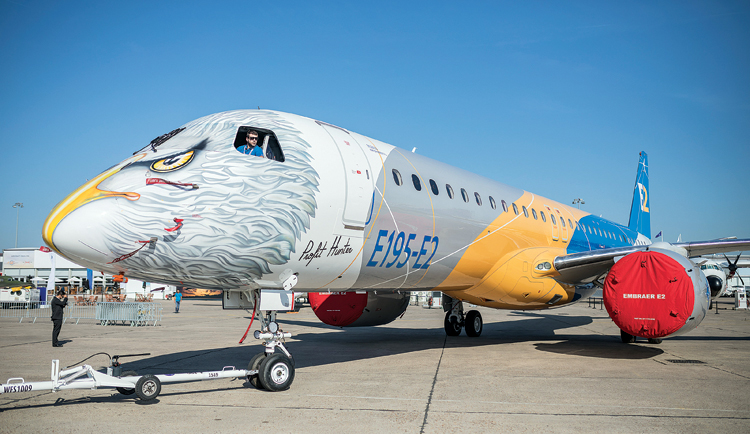INDIAN ARMED FORCES CHIEFS ON
OUR RELENTLESS AND FOCUSED PUBLISHING EFFORTS

SP Guide Publications puts forth a well compiled articulation of issues, pursuits and accomplishments of the Indian Army, over the years

I am confident that SP Guide Publications would continue to inform, inspire and influence.

My compliments to SP Guide Publications for informative and credible reportage on contemporary aerospace issues over the past six decades.
No Middle Seats: A step towards pass engers’ delight by Embraer
In concept and design, it is meant to punch above its weight and give passengers the feeling that they’re flying in a bigger aircraft. Aiming for a wide body feel, Embraer puts the focus on passenger space for economy passengers like no other jet does.

No middle seats. From a passenger point of view, that’s the biggest pull, the most compelling calling card for Embraer’s E2 family of regional jets, which sit between turbo props and the narrow body segments to create more options for profitable operations for civil airliners. Since early 2018, Embraer’s sales focus has been on the newly-introduced E190-E2, conceived and packaged to take on the Airbus A220.
Not even the stingiest airline can push middle seats into these single aisle, 2-2 configuration aircraft, with passengers getting wither a window or an aisle seat, and eliminating the shoulder-to-shoulder squeeze. In concept and design, it is meant to punch above its weight and give passengers the feeling that they’re flying in a bigger aircraft. Aiming for a wide body feel, it puts the focus on passenger space for economy passengers like no other jet does.
While legroom is determined by multiple seating configurations, some benefits are assured for passengers. There are no under-seat support rails blocking leg space, 40 per cent larger overhead bins can accommodate bigger carry-on baggage and larger windows make the cabin brighter. There’s also an option of a premium cabin with staggered seating for greater comfort and privacy. In different configurations, this regional jet can have 104 or 114 seats. The aircraft is noticeably quieter than most jets. While its designed to be a passenger pleaser, is agenda is on being “the world’s quietest, cleanest and most efficient new generation, single-aisle aircraft”. And it’s pitched as the Profit Hunter. Here’s why:
It’s business proposition is meant to be just as compelling as passenger appeal. The business case is built around a break even at 50 seats, as compared to 120 for narrow bodies like the A320 and Boeing 737.
Embraer claims operating costs for the E190-E2 are 20-to-25 per cent lower per trip as compared to an Airbus 320, and a 5 -to-10 per cent lower cost per seat.
“At 60 per cent of the cost of a narrow-body aircraft, it is significantly cheaper, which will reflect in reduced costs or lease money. Its 17.3 per cent fuel burn reduction means lower fuel costs. And it’s lighter weight means lower airport charges,” said Embraer’s Vice-President Asia-Pacific Cesar Pereira. “It’s a reliable aircraft which can be flown 7-to-8 times a day, with maintenance turnaround needed after 10,000 hours,” he added. Lower fuel burn is enabled by the all new high aspect ratio wing design.
There’s also an option of a premium cabin with staggered seating for greater comfort and privacy. The aircraft is noticeably quieter than most jets.
Pereira also reasoned that the Profit Hunter fits in on routes where narrow bodies are unviable. Aping the IndiGo model based on narrow body jets is tripping rival airlines, he argued. “IndiGo has a unique business model which has efficiencies built into it. Its cost base cannot be matched by others. Competitors are losing money trying to do the same thing. In the process, they’re reducing the quality of revenue. If there are lesser seats to be sold than in narrow body jets, airlines wouldn’t need to reduce costs. Copying the IndiGo model has reduced the per seat margins of Indian carriers to less than what Starbucks makes by selling one coffee,” he said, making a strong case for a reasoned fleet selection.
He also pitched the E2 jets as route openers for low cost carriers to smaller centres, in furtherance of the agenda for India’s Udan regional connectivity scheme.
The Brazilian company is a global leader in sales of aircraft in the 70-to-150 seat capacity with its E2 family of regional jets comprising the E175-E2, E190-E2 and E195-E2. It’s share of the market is 29 per cent. Over 1,700 of its jets are in operation with 111 airlines across 60 countries.
The first E190-E2 was delivered in April to Scandinavian Airlines’ regional subsidiary, Widerøe, and the airline is now flying three of the type around Norway.
The largest E2 customer is SkyWest, a regional airline affiliate flying for the likes of American Airlines, Delta, United and Alaska Airlines.
Alaska Airlines, Spirit and United have also been mentioned as likely customers.
AerCap, an independent aircraft-leasing company with airline customers around the world, signed the secondlargest E2 order, for more than 20 each of the larger E190-E2 and E195-E2 variants, and has confirmed Kazakhstan’s Air Astana as the first placement when their deliveries commence in 2019. Brazil’s Azul, Switzerland’s Helvetic, Kuwait’s Wataniya and China’s Tianjin Airlines have also ordered variants from the E2 family.





